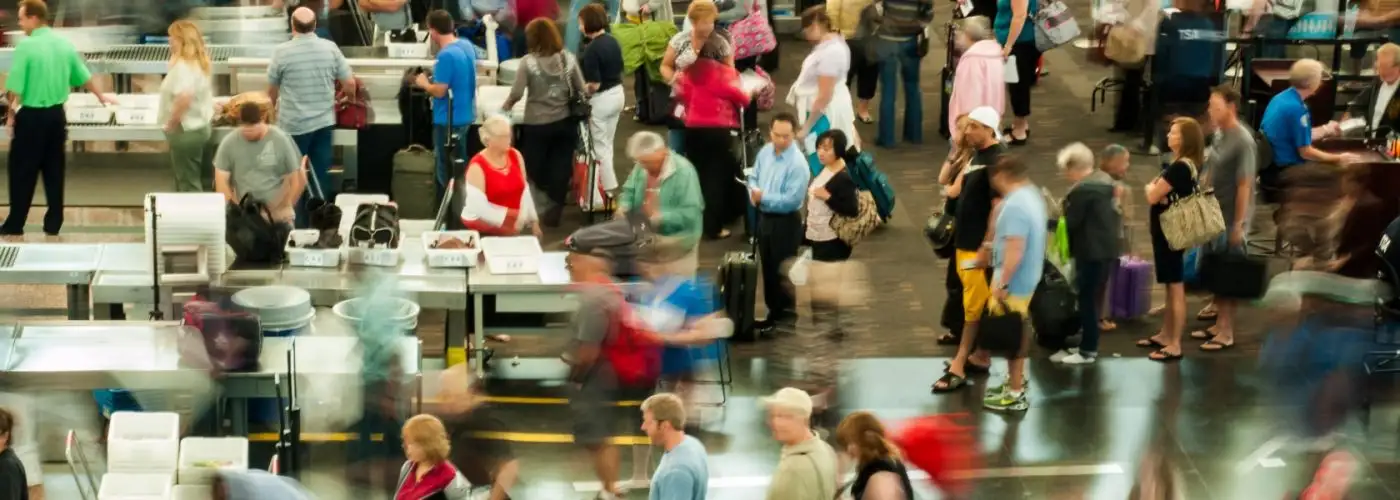It’s been almost 15 years since Richard Reid, better known as the shoe bomber, failed in his attempt to bring down an American Airlines flight with an explosive hidden in his shoe. And yet here we are, all these years later, still shuffling through TSA checkpoints in our socks or bare feet. Why, you might ask, are we still forced to do this?
It’s simple: A pair of sneakers may look harmless, but still, you never know. That’s the message TSA spokesman Michael McCarthy delivered last week at Chicago’s O’Hare airport. Referring to a normal-looking pair of sneakers, he said, “These look like everyday shoes, but they feel a little bit heavier. That’s because if you peel back the tongue there’s a mock explosive inside there and here’s the ignition.”
McCarthy was holding a demonstration to show why the TSA does what it does, following years of frustration and critiques over its guidelines and screening procedures. Travelers are understandably weary of processes put in place following 9/11 that, fairly or not, have come to be seen by many as more security theater than actual security.
McCarthy contends this is not the case, saying his organization’s protocols are “based on real-life events that occur or when intelligence tells us we should look for those items.” As an example, McCarthy displayed a normal-looking laptop that had a mock explosive device hidden inside. He also showed how a soda can could be hollowed out to accommodate a small explosive device that, in turn, could ignite a larger and more destructive one.
This is all true, of course, and important to remember. No one can reasonably dispute the necessity of an agency like the TSA or the importance of vigilant airport security. Recent airport attacks in Brussels and Istanbul prove that airports and the airline industry are still prime targets for terrorists.
Perhaps, though, whatever negative feelings the public has about the TSA have more to do with the perception that it’s slow to evolve. Take shoes, for example: Perhaps travelers aren’t dismissive of shoe bombs as a genuine threat, but skeptical that there isn’t a better way to screen for them? Why, in 15 years, haven’t we figured out a better solution? Why do some countries let you keep them on? We know the TSA has been working on this issue for years—I reported on it way back in 2010!—and that the technology exists in some form. And yet here we are.
To make matters worse, most travelers probably have probably slipped something past the TSA on one or two occasions, perhaps deliberately. I can recall a streak of three or four consecutive flights a few years back where I brought non-compliant liquids onto planes. Couple that with stories of actual potentially dangerous breaches—and equally outrageous stories of harmless items being confiscated—and the whole operation starts to feel questionable.
So to Mr. McCarthy’s primary point, that the TSA is essential and its procedures are based on actual, credible threats, there’s really no argument to be made. It’s important to remind people that we do need the TSA. But if the goal is strengthen the public’s trust and support of the agency, perhaps a more concerted and public effort to modernize operations would be more effective.
Readers, what do you think about the TSA these days?
More from SmarterTravel:
We hand-pick everything we recommend and select items through testing and reviews. Some products are sent to us free of charge with no incentive to offer a favorable review. We offer our unbiased opinions and do not accept compensation to review products. All items are in stock and prices are accurate at the time of publication. If you buy something through our links, we may earn a commission.
Related
Top Fares From
Today's Top Travel Deals
Brought to you by ShermansTravel
Shop and Save with Country Inns...
Patricia Magaña
 Hotel & Lodging Deals
Hotel & Lodging Deals
$229 -- Chicago: Discounted Rates and...
Francesca Miele
 Hotel & Lodging Deals
$229+
Hotel & Lodging Deals
$229+
$188 -- Honolulu: Save on Oceanview...
Abigail Lamay
 Hotel & Lodging Deals
$188+
Hotel & Lodging Deals
$188+




